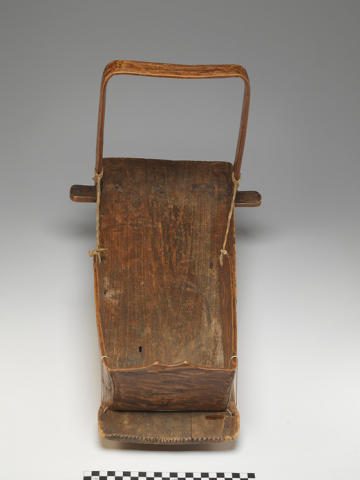John Silas Dikinaagan
Dikinaagan owned by the Silas family.
John B. Silas was an important leader in the business committee as well as an ordained minister. During the 20th century, Anishinabe Ministers ordained by the Methodist Church played an important role in unifying our tribe by traveling to our scattered communities. He met his wife, Estelle Squanda at a Methodist camp meeting and they married in 1907. They then started a ministry on the Isabella Reservation. In the 1930s, Silas was instrumental in the political reorganization that resulted in our modern tribal government.
The Anishinabek believe children are gifts from the Creator to be respected, guided, and loved. Families create beautiful cradleboards (dikinaagan) for their babies (abinoojiinsag). The dikinaagan protects the baby and allows them to see at an adult level to study language, facial expression and the rest of the world they live in. The dikinaagan reminds us of the importance of supporting and mentoring the next seven generations.
The first year of a baby's life was spent on a cradle board. At the top is a curved hoop or bow that was tied or lashed to a wooden brace that protected the baby's head and to support the blanket or the thin cloth that is used in the summer to provide protection from drafts or flies. The curved hoop or bow that is used to protect the baby's head was used to hang charms, coins, thimbles, bells, and other play things. A large piece of skin or a velvet sack or blanket was secured to the cradle to hold the baby and to be laced up around it. Over the skin, velvet sack, or blanket was a band that was usually embroidered with quill or bead work to hold the baby in place. Moss or the down of cattail rushes was put around the baby for warmth. To the top of the board was attached a long leather strap or thong that passed around the mother's forehead when she carried the cradle on her back. (Carrie Alberta Lyford's "Ojibwa Crafts" book; page 35)
Cradleboard (over 200 years old) made of carved wood with adjustable footrest suspended by buckskin strings, and bow, held together by bast (roots of the spruce tree boiled to make them pliable) which is threaded through holes and tied, with 37 notches into the wood to indicate the number of babies who used it.
Given to Reverend John Benjamin Silas (She-bah-gee-shig, Michigan Chippewa, 1880-1948) by an Indian family living near Pinconning, Michigan, at an unknown date; inherited by his widow Estella Marina Silas (Estella Squanda/Now-qua-kee-shie-go quah, Michigan Chippewa, 1883-1976); inherited by their grandson, Dr. John Rhodes, and donated to NMAI by Dr. Rhodes in 2012 in memory of Reverend John B. Silas and Pastor Estella Marina Squanda Silas.
Michigan, USA

